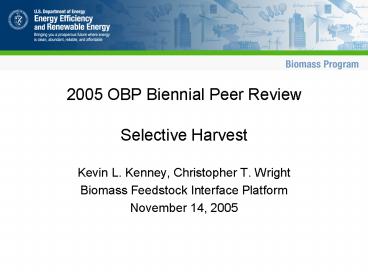2005 OBP Biennial Peer Review
1 / 15
Title: 2005 OBP Biennial Peer Review
1
2005 OBP Biennial Peer Review
- Selective Harvest
- Kevin L. Kenney, Christopher T. Wright
- Biomass Feedstock Interface Platform
- November 14, 2005
2
Overview
Work Objective
- Objective Decrease 2005 cost to 35/dry ton by
2015 for the purpose reducing sugar cost by
almost 2 cents per lb, for all Billion Ton Vision
Feedstocks - Budget About 2M per year from 2004 -2006
- Current Partners National Laboratories,
Universities, Equipment Industry - Developing Partners Agribusiness Commodity
Companies, Regional Feedstock Centers
Partnerships, Feedstock Interface to Biorefining
Partners
Note Sugar conversion cost estimate reductions
based on the 2005 post-enzyme subcontract
conversion case.
3
Pathway
- Pathway Impact
- B-Level Milestone Agriculture residue and
energy crop feedstocks available to a biorefinery
at 35/dry ton by 2015 - C-Level Milestones Production(10.00),
Harvest/Collect(12.50), Storage(1.75),
Transport(8.00), Preprocessing (2.75), System
Integration - Cost and Quality Improvements (dry biomass first,
wet second)
Agriculture Residue Pathway
Energy Crops Pathway
4
Approach
- 1. DOE Multi-Year Technical Plan Barriers for
Feedstock Supply can be grouped into - Cost - 35 / try ton (Operational and Capital
Costs) - Quality dockage, composition, conversion
efficiency (selective harvest, fractional
milling, in-storage fractional conversion) - Quantity biomass types (Billion Ton Study)
- 2. Develop preprocessing based feedstock supply
systems that interface biorefining conversion
processes to feedstock resources - Corn Stover
- Cereal Straw
- Switchgrass
5
Interim Stage Gate Overview
Feedstock Interface Core RD
Ag Residue Processing RD
Energy Crop Processing RD
Feedstock Supply Chain Analysis
Native Grass Utilization Project
Biomass Supply Systems Logistics
Harvest Collection
Feedstock Harvest Collection Assembly System
Biomass Power for Rural Development Chariton
Valley Switchgrass Project
Supply Forecast Analysis
Preprocessing
Classification of Biomass Physical Properties in
Preprocessing
UT Switchgrass Project
Multi-Component Harvesting Equipment for Sugars
Virtual Engineering Tools for Airstream
Separation
Biomass Structure Task
Storage
Systems Integration
Post-Harvest Physiology of Biomass Storage
Harvesting Collection
Collection, Commercial Processing, and
Utilization of Corn Stover
6
Summarized Reviewer Comments
- This project was categorized by the reviewers as
engineering tool development rather than an RD
project subject to Stage-Gate decision-making.
It was observed that the modeling tool(s) were
general and that increased focus on biomass and
biomass-related applications would be of greater
benefit. - Recommendation It is important to identify
biomass feedstock characteristics that are
important to a biorefinery and show how these
tools can help provide feedstock with these
characteristics more cheaply/efficiently. The
question of where processing is most effectively
done needs to be answered. What are the
trade-offs on where you effect the separations?
These questions need to be answered and the tool
tied directly to real-world equipment
development.
7
DOE Response
- Project focused on the relevance to a specific
biomass application selective harvest - Identified necessary approach
- Identified theoretical targets
- Identified practical targets
- Developed and applied a computational engineering
tool to achieve practical targets - Field tested functionality of engineered solution
- Analyzed residue fractions to establish the value
of selective harvest not according to
theoretical separation targets, but according to
actual separations accomplished with a grain
combine
8
DOE Response
Practical Quality Targets
Results
Optimize Engineering Design Analysis
Testing
9
Ongoing Tasks Feedstock Conversion Interface
(Quality)
Anatomical Plant Parts Theoretical Quality
Targets
Composition
Techno-economic analysis Identifies differential
product yield potential and conversion efficiency
for plant parts
Pretreatment Severity
Motivation for selective harvest
10
Ongoing Tasks Feedstock Conversion Interface
(Quality)
Practical Quality Targets
Hand Fractionation vs. Combine
Fractionation
Residue Fractions Chaff (hulls, awns,
leaves) Straw (internodal stem, nodes)
Anatomical Fractions Chaff (hulls, awns,
etc.) Leaves Internodal Stem Nodes
11
Ongoing Tasks
Computational Engineering Approach
Objective Design a baffle to accomplish
high-fidelity residue separation Approach
Develop virtual engineering model to design
baffle separator by simulating baffle performance
to (1) determine the effect of the baffle on the
airflow of the combine cleaning system and (2)
predict the effectiveness of the baffle in
separating the residue streams. Model
Components
- Combine geometry
- Baffle design canvas (CAD tool)
- Embedded, interactive CFD model of the
single-phase air flow of the combine cleaning
system
12
Ongoing Tasks
Testing
- Baffle increased the chaff stream purity from 64
to 93 - The 7 straw is result if spearing through the
concaves
Shows that chaff mixing with the straw is not a
problem
13
Ongoing Tasks
Compositional Analysis
- Fractionation of residue stream has statistically
significant effect on the composition of the the
straw and chaff residue streams - High-fidelity separation has largest effect on
glucan and ash content
14
Ongoing Tasks
Results
- Straw fraction has highest theoretical ethanol
yield - No Baffle no value of selective harvest at this
level of fractionation - Baffle 11 gallons of ethanol per dry ton
difference between chaff and straw streams
significant differential value of selective
harvest - Whole stover ethanol yield approximated by dashed
line. 0.5 increase for no-baffle straw, 3.3
increase for baffle straw - Baffle Do not loose higher value straw in
chaff stream
15
Summary and Future Work































